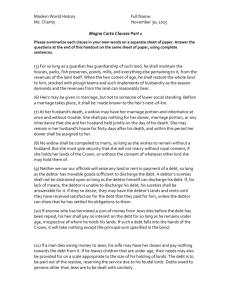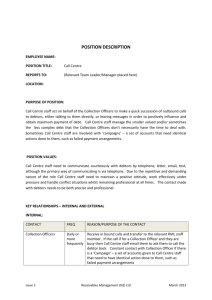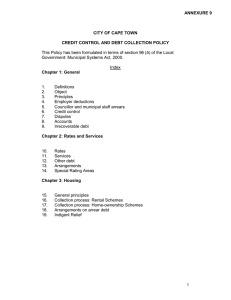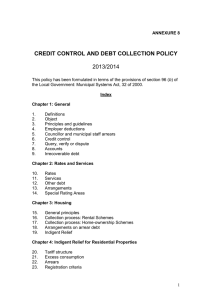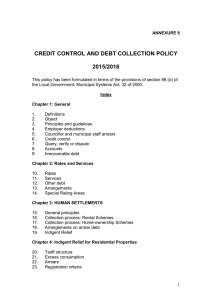Fact Sheet ECM&C v1
advertisement
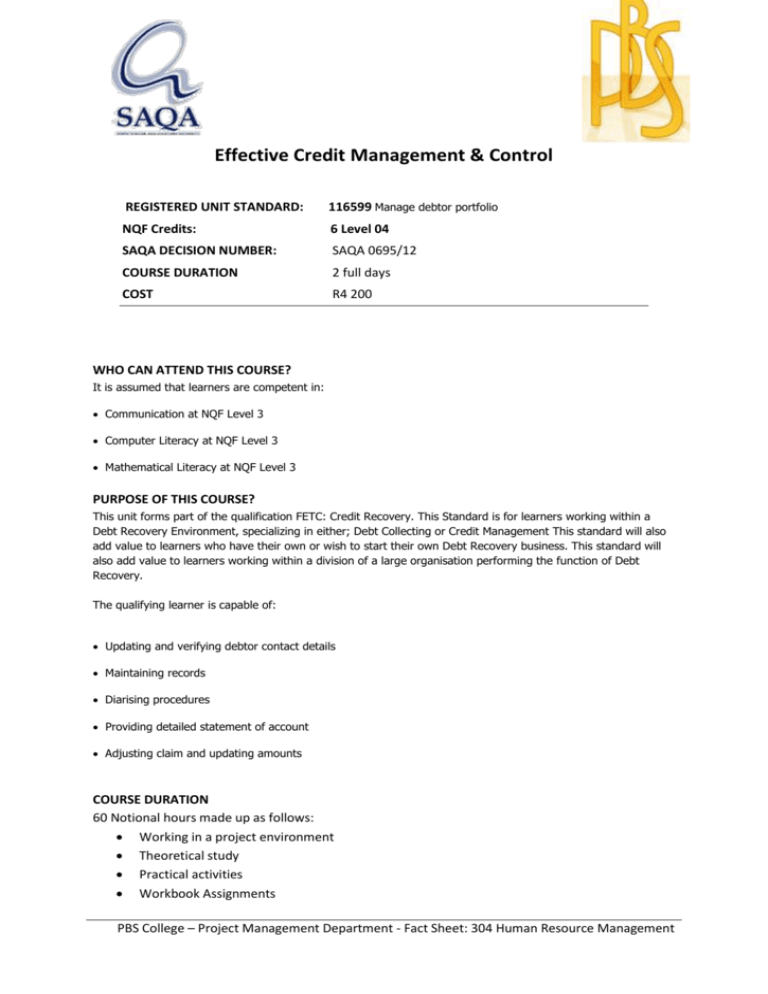
Effective Credit Management & Control REGISTERED UNIT STANDARD: 116599 Manage debtor portfolio NQF Credits: 6 Level 04 SAQA DECISION NUMBER: SAQA 0695/12 COURSE DURATION 2 full days COST R4 200 WHO CAN ATTEND THIS COURSE? It is assumed that learners are competent in: Communication at NQF Level 3 Computer Literacy at NQF Level 3 Mathematical Literacy at NQF Level 3 PURPOSE OF THIS COURSE? This unit forms part of the qualification FETC: Credit Recovery. This Standard is for learners working within a Debt Recovery Environment, specializing in either; Debt Collecting or Credit Management This standard will also add value to learners who have their own or wish to start their own Debt Recovery business. This standard will also add value to learners working within a division of a large organisation performing the function of Debt Recovery. The qualifying learner is capable of: Updating and verifying debtor contact details Maintaining records Diarising procedures Providing detailed statement of account Adjusting claim and updating amounts COURSE DURATION 60 Notional hours made up as follows: Working in a project environment Theoretical study Practical activities Workbook Assignments PBS College – Project Management Department - Fact Sheet: 304 Human Resource Management Building a Portfolio of Evidence PBS College – Project Management Department - Fact Sheet: 304 HR Management COURSE CONTENT: 1. Update and verify debtor contact details (Debtor includes individual or joint and several parties to debt) 1.1. Telephone numbers for debtors are obtained and validated using organizational procedures. (Telephone numbers obtained extend to cellular, home, spouse, next of kin, and the numbers of references) 1.2. Address details for debtors are validated and recorded using organizational procedures (Address details include physical and postal addresses) 1.3. Employer details of debtors are validated and recorded using organizational procedures 1.4. Sureties relating to debtor accounts are validated and recorded using organizational procedures 1.5. Employment details are validated and recorded using organizational procedures (Employment details include but are not limited to the name of employee and clock number) 1.6. Marriage status and type of marriage contract is ascertained using organizational procedures (Marriage contracts extend to Community of Property and Antenuptual Contracts) 2. Maintain records 2.1. Case history is updated as per debtor interaction 2.2. Details of conversation are clearly captured in relevant files and format (Relevant files include but are not limited to written, voice recording and computerized) 2.3. Media Actions and dates for follow-up are diarised using organizational procedures (Media includes but are not limited to written, voice recording and computerised) 3. Diarise procedures 3.1. Notes for follow-up calls are captured in accordance with organisational procedures 3.2. Prioritisation for daily, weekly and monthly actions are reviewed on an on-going basis 3.3. Any actions outside of work parameters are referred to supervisor or relevant authority for permission 3.4. Handover of case to a third party is ensured when necessary and according to organizational procedures and policy (Third parties include but are not limited to lawyers, debt collectors, sheriffs, court, trusts) 4. Provide detailed statement of account 4.1. Outstanding balances are calculated and provided to debtor (Calculations include but are not limited to interest, debits, credits and receipts, in-duplum. Calculations include manual and automated calculations) 4.2. Fees are added to statements where relevant 4.3. Legislative processes that regulate interest are adhered to at all times 4.4. A statement that reflects all debits and credits is produced in the required format and time scale 4.5. Client instructions for debt collecting liquidation sequence is considered in relation to interest, cost and capital (Debits relate to interest percentage, days on which interest is calculated, legislative processes. Credits include but are not limited to legal costs, debt collection costs, VAT (Value Added Tax)) 4.6. Appropriate journals are initiated as per organisational requirements (Journals include debits and credits) 5. Adjust claim and update amounts 5.1. Appropriate journals are initiated according to organizational procedures and policy (Journals include debits and credits) 5.2. Recalculations are undertaken to determine new balances 5.3. Financial records are adjusted and updated according to organizational procedures and policy STUDY PATH This is part of the Strategic Credit Management Module of the Credit Management Certificate course. This Unit can be taken on it’s own, in isolation, but Ideally the learner should continue with the Full Module and then the full Credit Management Certificate. PBS College – Project Management Department - Fact Sheet: 304 HR Management QUALIFICATION OBTAINED After completion of this course in Basic Bookkeeping, as well as the successful completion of the individual Portfolio of Evidence, the learner will obtain the Credit Business Management Certificate, carrying 13 SAQA NQF Credits. NEXT STEPS After completion of this course, the learner could choose to complete the Credit Management Certificate. PBS College – Project Management Department - Fact Sheet: 304 HR Management


